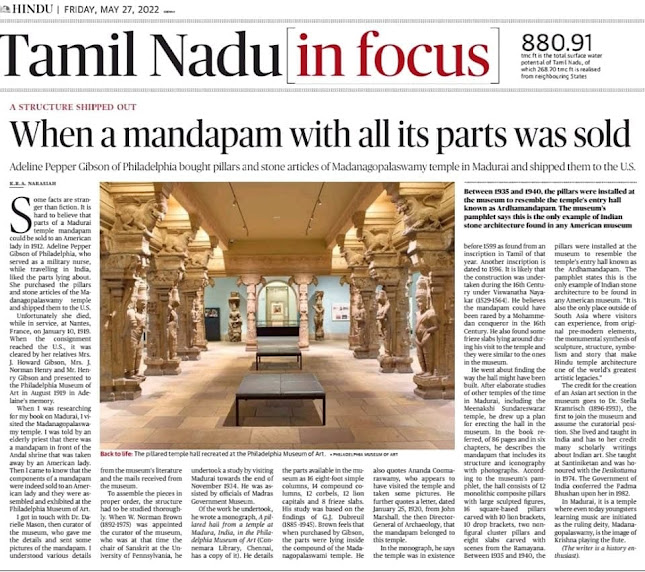அமெரிக்கா சென்ற மதுரை மதனகோபாலசுவாமி கோயில் கல்தூண் மண்டபம் மீட்கப் படுமா?

When a mandapam with all its parts was sold
KRA Narasiah MAY 25, 2022
Unfortunately she died, while in service, at Nantes, France, on January 10, 1919. When the consignment reached the U.S., it was cleared by her relatives Mrs. J. Howard Gibson, Mrs. J. Norman Henry and Mr. Henry Gibson and presented to the Philadelphia Museum of Art in August 1919 in Adelaine’s memory.
When I was researching for my book on Madurai, I visited the Madanagopalaswamy temple. I was told by an elderly priest that there was a mandapam in front of the Andal shrine that was taken away by an American lady. Then I came to know that the components of a mandapam were indeed sold to an American lady and they were assembled and exhibited at the Philadelphia Museum of Art.
I got in touch with Dr. Darielle Mason, then curator of the museum, who gave me the details and sent some pictures of the mandapam. I understood various details from the museum’s literature and the mails received from the museum.
To assemble the pieces in proper order, the structure had to be studied thgoroughly. When W. Norman Brown (1892-1975) was appointed the curator of the museum, who was at that time the chair of Sanskrit at the University of Pensylvania, he undertook a study by visiting Madurai towards the end of November 1934. He was assisted by the officials of Madras Government Museum.
Of the work he undertook, he wrote a monograph, A pillared hall from a temple at Madura in the Philadelphia Museum of Art (Connemara Library, Chennai, has a copy of it). He details the parts available in the museum as 16 eight-foot simple columns, 14 compound columns, 12 corbels, 12 lion capitals and 8 frieze slabs. His study was based on the findings of G.J. Dubreuil (1885 -1945). Brown feels that when purchased by Gibson, the parts were lying inside the compound of the Madanagopalaswami temple. He also quotes Ananda Coomaraswami, who appears to have visited the temple and taken some pictures. He further quotes a letter, dated January 25, 1920, from John Marshall, the then Director-General of Achaeology, that the mandapam belonged to this temple.
In the monograph, he says the temple was in existence before 1599 as found from an inscription in Tamil of that year. Another inscription is also dated to 1596. It is likely that the construction was undertaken during the 16th Century under Viswanatha Nayakar (1529-1564). He believes the mandapam could have been razed by a Mohammedan conqueror in the 16th Century. He also found some frieze slabs lying around during his visit to the temple and they were similar to the ones in the museum.
He went about finding the way the hall might have been built and after elaborate studies of other temples of the time in Madurai, including the Meenakshi Sundareswarar temple, drew a plan for erecting the hall in the museum. In the book referred, of 86 pages and in six chapters, he describes the mandapam that includes its structure and iconography with photographs.
According to the museum’s pamphlet, the hall consists of 12 monolithic composite pillars with large sculpted figures, 16 square-based pillars carved with 10 lion brackets, 10 drop brackets, two non-figural cluster pillars and eight slabs carved with scenes from the Ramayana. Between 1935 and 1940, the pillars were installed at the museum to resemble the temple’s entry hall known as the Artha Mandapam. The pamphlet states this is the only example of Indian stone architecture to be found in any American museum. “It is also the only place outside of South Asia where visitors can experience, from original pre-modern elements, the monumental synthesis of sculpture, structure, symbolism and story that make Hindu temple architecture one of the world’s greatest artistic legacies.”
For the creation of an Asian art section in the museum, credit goes to Dr. Stella Kramrisch (1896-1993), the first to join the museum and assume the curatorial position. It was because of her that the museum has a separate section on Asian art. She lived and taught in India and has to her credit many scholarly writings about Indian art. She taught at Shanti Niketan and was honoured with the Desikottama in 1974 and the Government of India conferred the Padmabhushan upon her in 1982.
In Madurai, it is a temple where even today youngsters learning music are initiated as the ruling deity Madanagopalaswamy is the image of Krishna playing the flute.


.jpeg)





No comments:
Post a Comment